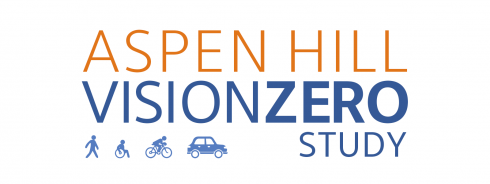
Applications for advisory group members are due on December 21
SILVER SPRING, MD – The Montgomery County Planning Department seeks members of the community to participate in its Aspen Hill Vision Zero Study Advisory Group. The study is focused on identifying existing barriers to safety and exploring ways to improve conditions in the Aspen Hill area. It will result in recommended strategies to make major intersections safer for all road users, pedestrians and bicyclists.
The Aspen Hill Vision Zero Study will identify strategies to:
- Enhance connectivity by improving safety for all road users.
- Explore solutions to reduce speeds and conflicts on the road.
- Establish direct, safe connections to transit, community facilities and other destinations.
- Examine the potential for redevelopment of commercial shopping centers.
The Montgomery County Planning Board will appoint between 8 and 12 community members to represent Aspen Hill residents and a variety of interest groups. Members will be selected through an application process to ensure the Advisory Group represents diverse perspectives.
The advisory group will meet approximately once per month from January 2019 to July 2019 to provide advice and feedback to Montgomery Planning staff members as they develop a working draft of the Aspen Hill Vision Zero study. All meetings will take place on weekday evenings at venues in the Aspen Hill area.
Montgomery Planning encourages interested community members to apply to be an Aspen Hill Vision Zero Study Advisory Group member by Friday, December 21, 2018 via the online application.
“One transportation-related death or severe injury is one too many. It’s unacceptable and preventable. We have the tools – and the responsibility – to protect our neighbors as they move about our communities. But we need the community’s help,” says project manager Maren Hill of the Aspen Hill Vision Zero Study project. “While we have been working with the Aspen Hill community on this Vision Zero Study for a few months now, ongoing feedback from an advisory group will give us in-depth insight on how to improve safety for all modes of transportation in Aspen Hill.”
The study area includes the commercial developments near Georgia Avenue, Connecticut Avenue and Aspen Hill Road, including Northgate Shopping Center, Aspen Hill Shopping Center, Aspen Manor Shopping Center, Home Depot and Kmart. It also includes the area south of Bel Pre Road between Georgia and Connecticut Avenues, and the area south of Aspen Hill Road between Georgia Avenue and Parkland Drive and north of Matthew Henson Park.
The Aspen Hill Vision Zero Study process involves engaging residents, business owners and civic associations as well as collecting and analyzing data to inform priorities. Recommendations from the study will be presented to community members, the Planning Board and County Council.
For more information, contact Maren Hill at maren.hill@montgomeryplanning.org or (301) 650-5613.
Montgomery Planning’s Commitment to Vision Zero
Vision Zero is a proven strategy to prevent transportation-related deaths and severe injuries. This policy represents a fundamental change in thinking about roadway planning and design priorities. It changes the focus from vehicular mobility to safe mobility for all people regardless of their mode of transportation.
Engineering, education and enforcement can help us anticipate human error to save lives and reduce the frequency and severity of crashes.
Through its 2016 resolution, Montgomery County committed to creating a Vision Zero environment to eliminate traffic fatalities and severe injuries.
Montgomery Planning is also committed to Vision Zero — to putting safety first for all people in all communities, whether they’re on foot, on bicycles, in cars or using transit. As the agency charged with creating a vision for the county, Montgomery Planning has a unique role to play in engaging the community to re-envision our auto-oriented roadways as safe, complete streets.
Montgomery Planning has been incorporating safety into master plans for some time. Vision Zero offers an opportunity to step up these efforts. As safety increasingly becomes a central focus of planning efforts, we can look for ways to save lives by reducing speeds, decreasing the chance for collisions and recommending land use changes, especially on suburban and arterial roadways.
When well implemented, plans can support Vision Zero by changing our built environment from one that is dominated by cars and focused on traveling quickly over long distances to one that is equitable for all users, regardless of transportation mode, and one that prioritizes life and safety.
Whether applied to an urban, suburban or rural area, Vision Zero policy fundamentals are the same: saving lives means reducing speeds and decreasing the chance for collisions.